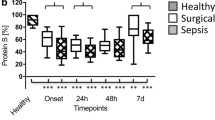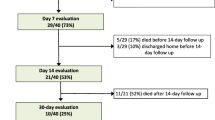Abstract
Purpose
To investigate the association between consecutively measured thromboelastographic (TEG) tracings and outcome in patients with severe sepsis.
Methods
Multicentre prospective observational study in a subgroup of the Scandinavian Starch for Severe Sepsis/Septic Shock (6S) Trial (NCT00962156) comparing hydroxyethyl starch (HES) 130/0.42 vs. Ringer’s acetate for fluid resuscitation in severe sepsis. TEG (standard and functional fibrinogen) was measured consecutively for 5 days, and clinical data including bleeding and death was retrieved from the trial database. Statistical analyses included Cox regression with time-dependent covariates and joint modelling techniques.
Results
Of 267 eligible patients, we analysed 260 patients with TEG data. At 90 days, 68 (26 %) had bled and 139 (53 %) had died. For all TEG variables, hypocoagulability according to the reference range was significantly associated with increased risk of death. In a linear model, hazard ratios for death were 6.03 (95 % confidence interval, 1.64–22.17) for increased clot formation speed, 1.10 (1.04–1.16) for decreased angle, 1.09 (1.05–1.14) for decreased clot strength and 1.12 (1.06–1.18) for decreased fibrinogen contribution to clot strength (functional fibrinogen MA), showing that deterioration towards hypocoagulability in any TEG variable significantly increased the risk of death. Patients treated with HES had lower functional fibrinogen MA than those treated Ringer’s acetate, which significantly increased the risk of subsequent bleeding [HR 2.43 (1.16–5.07)] and possibly explained the excess bleeding with HES in the 6S trial.
Conclusions
In our cohort of patients with severe sepsis, progressive hypocoagulability defined by TEG variables was associated with increased risk of death and increased risk of bleeding.


Similar content being viewed by others
References
Angus DC, van der Poll T (2013) Severe sepsis and septic shock. N Engl J Med 369:840–851. doi:10.1056/NEJMra1208623
Bakhtiari K, Meijers JCM, de Jonge E, Levi M (2004) Prospective validation of the International Society of Thrombosis and Haemostasis scoring system for disseminated intravascular coagulation. Crit Care Med 32:2416–2421
Ostrowski SR, Windeløv NA, Ibsen M et al (2012) Consecutive thrombelastography clot strength profiles in patients with severe sepsis and their association with 28-day mortality: a prospective study. J Crit Care. doi:10.1016/j.jcrc.2012.09.003
Johansson PI, Stensballe J, Vindeløv N et al (2010) Hypocoagulability, as evaluated by thrombelastography, at admission to the ICU is associated with increased 30-day mortality. Blood Coagul Fibrinolysis 21:168–174. doi:10.1097/MBC.0b013e3283367882
Müller MC, Meijers JC, Vroom MB, Juffermans NP (2014) Utility of thromboelastography and/or thromboelastometry in adults with sepsis: a systematic review. Crit Care 18:R30. doi:10.1186/cc13721
Perner A, Haase N, Guttormsen AB et al (2012) Hydroxyethyl starch 130/0.42 versus Ringer’s acetate in severe sepsis. N Engl J Med 367:124–134. doi:10.1056/NEJMoa1204242
American College of Chest Physicians/Society of Critical Care Medicine (1992) American College of Chest Physicians/Society of Critical Care Medicine Consensus Conference: definitions for sepsis and organ failure and guidelines for the use of innovative therapies in sepsis. Crit Care Med 20:864–874
Perner A, Haase N, Wetterslev J et al (2011) Comparing the effect of hydroxyethyl starch 130/0.4 with balanced crystalloid solution on mortality and kidney failure in patients with severe sepsis (6S-Scandinavian starch for severe sepsis/septic shock trial): study protocol, design and rationale fora double-blinded randomised clinical trial. Trials 12:24. doi:10.1186/1745-6215-12-24
Haase N, Wetterslev J, Winkel P, Perner A (2013) Bleeding and risk of death with hydroxyethyl starch in severe sepsis: post hoc analyses of a randomized clinical trial. Intensive Care Med 39:2126–2134. doi:10.1007/s00134-013-3111-9
Von Elm E, Altman DG, Egger M et al (2008) The strengthening the reporting of observational studies in epidemiology (STROBE) statement: guidelines for reporting observational studies. J Clin Epidemiol 61:344–349. doi:10.1016/j.jclinepi.2007.11.008
Le Gall JR, Lemeshow S, Saulnier F (1993) A new Simplified Acute Physiology Score (SAPS II) based on a European/North American multicenter study. JAMA 270:2957–2963
Vincent JL, Moreno R, Takala J et al (1996) The SOFA (Sepsis-related Organ Failure Assessment) score to describe organ dysfunction/failure. On behalf of the Working Group on Sepsis-Related Problems of the European Society of Intensive Care Medicine. Intensive Care Med 22:707–710
Nates JL, Cárdenas-Turanzas M, Wakefield C et al (2010) Automating and simplifying the SOFA score in critically ill patients with cancer. Health Informatics J 16:35–47. doi:10.1177/1460458209353558
Coppell JA, Thalheimer U, Zambruni A et al (2006) The effects of unfractionated heparin, low molecular weight heparin and danaparoid on the thromboelastogram (TEG): an in vitro comparison of standard and heparinase-modified TEGs with conventional coagulation assays. Blood Coagul Fibrinolysis 17:97–104. doi:10.1097/01.mbc.0000203859.62739.25
Rizopoulos D (2012) Joint models for longitudinal and time-to-event data, 1st edn. Chapman & Hall/CRC Biostatistics Series, London
Gabriel SE, Normand S-LT (2012) Getting the methods right—the foundation of patient-centered outcomes research. N Engl J Med 367:787–790. doi:10.1056/NEJMp1207437
Schafer JL (1999) Multiple imputation: a primer. Stat Method Med Res 8:3–15
Gonano C, Sitzwohl C, Meitner E et al (2006) Four-day antithrombin therapy does not seem to attenuate hypercoagulability in patients suffering from sepsis. Crit Care 10:R160. doi:10.1186/cc5098
Daudel F, Kessler U, Folly H et al (2009) Thromboelastometry for the assessment of coagulation abnormalities in early and established adult sepsis: a prospective cohort study. Crit Care 13:R42. doi:10.1186/cc7765
Sivula M, Pettilä V, Niemi TT et al (2009) Thromboelastometry in patients with severe sepsis and disseminated intravascular coagulation. Blood Coagul Fibrinolysis 20:419–426. doi:10.1097/MBC.0b013e32832a76e1
Brenner T, Schmidt K, Delang M et al (2012) Viscoelastic and aggregometric point-of-care testing in patients with septic shock—cross-links between inflammation and haemostasis. Acta Anaesthesiol Scand 56:1277–1290. doi:10.1111/j.1399-6576.2012.02750.x
Adamzik M, Langemeier T, Frey UH et al (2011) Comparison of thrombelastometry with simplified acute physiology score II and sequential organ failure assessment scores for the prediction of 30-day survival: a cohort study. Shock 35:339–342. doi:10.1097/SHK.0b013e318204bff6
Massion PB, Peters P, Ledoux D et al (2012) Persistent hypocoagulability in patients with septic shock predicts greater hospital mortality: impact of impaired thrombin generation. Intensive Care Med 38:1326–1335. doi:10.1007/s00134-012-2620-2
Nates JL, Cattano D, Chelly JE, Doursout M-F (2014) Study of acute hemocoagulation changes in a porcine endotoxemic shock model using thrombelastography. Transl Res. doi:10.1016/j.trsl.2014.09.002
Hartog CS, Reuter D, Loesche W et al (2011) Influence of hydroxyethyl starch (HES) 130/0.4 on hemostasis as measured by viscoelastic device analysis: a systematic review. Intensive Care Med 37:1725–1737. doi:10.1007/s00134-011-2385-z
Mittermayr M, Streif W, Haas T et al (2007) Hemostatic changes after crystalloid or colloid fluid administration during major orthopedic surgery: the role of fibrinogen administration. Anesth Analg 105:905–917. doi:10.1213/01.ane.0000280481.18570.27
Fenger-Eriksen C, Jensen TM, Kristensen BS et al (2009) Fibrinogen substitution improves whole blood clot firmness after dilution with hydroxyethyl starch in bleeding patients undergoing radical cystectomy: a randomized, placebo-controlled clinical trial. J Thromb Haemost 7:795–802
Gluud C, Gluud LL (2005) Evidence based diagnostics. BMJ 330:724–726
Gluud C, Brok J, Gong Y, Koretz R (2007) Hepatology may have problems with putative surrogate outcome measures. J Hepatol 46:734–742
Afshari A, Wikkelsø A, Brok J et al (2011) Thrombelastography (TEG) or thromboelastometry (ROTEM) to monitor haemotherapy versus usual care in patients with massive transfusion. Cochrane Database Syst Rev 3:CD007871. doi:10.1002/14651858.CD007871.pub2
Acknowledgments
We thank our research nurses Maj-Brit Kjær, Kis Uhre, Vibeke Christiansen, Vibeke Knudsen and Carsten Pedersen (collection of blood samples and clinical data), Jakob Stensballe, Karin Magnussen, Pernille Andersen, Karen Dyeremose, Randa Zoel-Ghina and Helena Stjernkvist from the blood banks (TEG analyses) and patients, relatives and clinical staff at the four participating sites. No specific compensation was provided to these individuals.
Conflicts of interest
The department of intensive care at Rigshospitalet receives funds for research from CSL Behring, Fresenius Kabi, Cosmed and Bioporto. The 6S trial was funded by the Danish Research Councils and supported by B Braun Melsungen and the ACTA foundation. No other disclosures were reported. The present substudy was funded by Rigshospitalets Research Council, the AP Møller Foundation for Advancement of Medical Science and the Danish Society of Anaesthesiology and Intensive Care Medicine. The study funders had no role in the design and conduct of the study; collection, management, analysis and interpretation of the data; preparation, review or approval of the manuscript; and decision to submit the manuscript for publication.
Author information
Authors and Affiliations
Corresponding author
Additional information
Take-home message: In patients with severe sepsis, deterioration towards hypocoagulability in any thromboelastography variable increases the risk of death.
Electronic supplementary material
Below is the link to the electronic supplementary material.
Rights and permissions
About this article
Cite this article
Haase, N., Ostrowski, S.R., Wetterslev, J. et al. Thromboelastography in patients with severe sepsis: a prospective cohort study. Intensive Care Med 41, 77–85 (2015). https://doi.org/10.1007/s00134-014-3552-9
Received:
Accepted:
Published:
Issue Date:
DOI: https://doi.org/10.1007/s00134-014-3552-9




